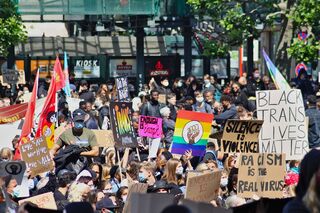
Bias
Competing Stereotypes and Common Protesting Identities
Tension between different stereotypes during the Black Lives Matter movement.
Posted July 7, 2020 Reviewed by Abigail Fagan
As Black Lives Matter movements are gaining support, many people are arguing that our youth are needed to speak up for change. My next two blog posts were inspired by some of our summer undergraduate interns. The Duke Psychology and Neuroscience National Science Foundation Funded REU (Research Experience for Undergraduates), hosted by myself and Drs. Makeba Wilbourn and Gregory Samanez-Larkin, provides underrepresented students with the skills and support needed to begin developing their scholar-researcher identities.
This first piece was motivated by insights from one of our interns and a member of the Indian American community, Rishi Krishnamurthy. Rishi highlighted one seemingly underappreciated fact: One of the police officers involved in the murder of George Floyd was Asian American. With insights from Rishi, I discuss racial stereotypes and faced by Asian Americans and Black Americans and the relationship between the two.

American society treats Asian Americans as a racial monolith with little consideration of how class and ethnicity shape their experiences. For example, prejudice against East Asian Americans presumed to be carrying COVID-19 can occur just because assailants assume their victims are Chinese. But different Asian-American communities have different histories and different relationships with other racial groups. Thus, every Asian-American group approaches American anti-Blackness from unique historical and cultural perspectives.
Rishi noted that Indian Americans may be socialized more on issues of colorism, which is the practice of discrimination against darker-skinned people, stereotyping them as ugly, low-status, and/or unclean. In some Indian states, research has demonstrated that higher-caste groups have significantly lighter skin than lower-caste groups. This pattern of worse socioeconomic outcomes for darker-skinned people dovetails with American anti-blackness. Intuitively, drawing upon the effects of colorism along with the historical and contemporary implications of India’s caste system should help the Indian community create a natural, cross-cultural connection to the U.S. Black struggle. But additional factors hint at why this might not always be the case.
A second issue is the "model minority" stereotype or the "model minority myth." Historically, the model minority label has been based entirely on stereotypes of Asian Americans as intelligent, culturally assimilated, and hard-working. Asian Americans were first stereotyped this way after the Second World War, when diplomacy with Asian countries and the return of Japanese Americans from internment camps made it important to cast Asian Americans as “superior” minorities. Their largely peaceful resettlement back into American society was compared to Black protests as the American Civil Rights Movement began in the late 1950s. That comparison, some historians argue, has been used to pit racial minorities against each other ever since.
Thus, positive stereotypes of Asian Americans can uphold negative stereotypes of other groups, which ultimately enables anti-Black attitudes. Indian Americans are especially prone to being cast as “model minorities” in contrast to Black individuals, since the model minority dynamic affords Indian individuals and other “high-performing” Asian minorities the opportunity to succeed through hard work while avoiding systemic persecution.
Model minorities can avoid being grouped with Black people, and thus members of those groups may also fail to understand why Black people face a different set of life outcomes (e.g., if they can do it, why can you). Accordingly, Rishi mentioned that “the economic success of many Indians in the U.S. coupled with a lack of discussion about structural racism and endorsement of model minority stereotypes has kept our communities from engaging fully with Black issues.”
Recent psychology research supports this relationship between Black and Asian American stereotypes, proposing that race in America is viewed two-dimensionally. Using this model, people consider racial groups superior (positive) or inferior (negative) on one axis, and more or less foreign on another axis. For example, participants evaluated African Americans as inferior and less foreign, but Asian Americans as superior and more foreign.
Though positive stereotypes (e.g., Asians are good at math) can be harmful for Asian Americans academically and emotionally, the negative stereotypes and discrimination that Black people face are linked with detrimental health outcomes. “These impacts are cause for Asian Americans to work with our communities to break down harmful stereotypes about Asian success and the Black struggle, rejecting the two-axis, oppositional racial dynamic. Establishing that these racial stereotypes feed off of one another and talking through the key role Black people play in fighting for all minority rights can close the perceived gap between Asian and Black communities,” Rishi said. Thus, ignorance of this oppositional relationship between positive Asian American and negative Black stereotypes is a third factor contributing to the lack of discussion about the Asian officer’s role since many Asian Americans have not been held accountable for their anti-Black attitudes.
And this is all because we dislike people we think are different from ourselves. Social identity theory argues our sense of self is based on constant ingroup versus outgroup comparisons—we favor, protect, and support people who are like us and discriminate against people who are different. But the Black Lives Matter protests are blurring those lines, bringing ingroups and outgroups together for one cause—ending systemic racism. These protests are perhaps serving as a real-world example of intergroup contact theory which argues that positive, meaningful contact can shift our attitudes about outgroups, and expand who we consider our ingroup.

And this ingroup expansion is starting now. Rishi said, “There are two types of events being put on by Indian-American organizations near me. Some are conversations between Indian-American community leaders and members, where they discuss the root causes of Indian anti-Blackness and their community’s responsibility to support Black causes. These are great for educating people within their ingroup about fighting racism. Others are focused on solidarity. I’ve been to demonstrations targeted at immigrants or South Asians which may make people feel like they’re protesting with their ingroup, which can make it easier for them to get involved.”
Rishi also surmised that minority community responses have perhaps created a common ingroup identity between Asian and Black minorities such as “activists,” reducing bias and distance between groups. Race is often thought of in a hierarchy with White individuals at the top and Black individuals at the bottom. Thus, this common “protesting” identity could shift one’s social dominance orientation (SDO) or perceived social hierarchy. We know that stronger SDO endorsements are associated with less empathy, altruism, and tolerance for others. Thus, debunking positive and negative racial stereotypes within and between minority communities may make it harder to justify the American racial hierarchy.
In sum, racial outgroup members who listen and hear what Black people have to say about racism in the U.S. may lead to questioning of their own ingroup biases. In Rishi’s experience, “People who go between ethnic communities are in a unique position. They can show the Black community that they’re there to fight with them and take their messages back to their own ingroup to start conversations about how ending colorism, discrimination, and racism is everyone’s responsibility.”



